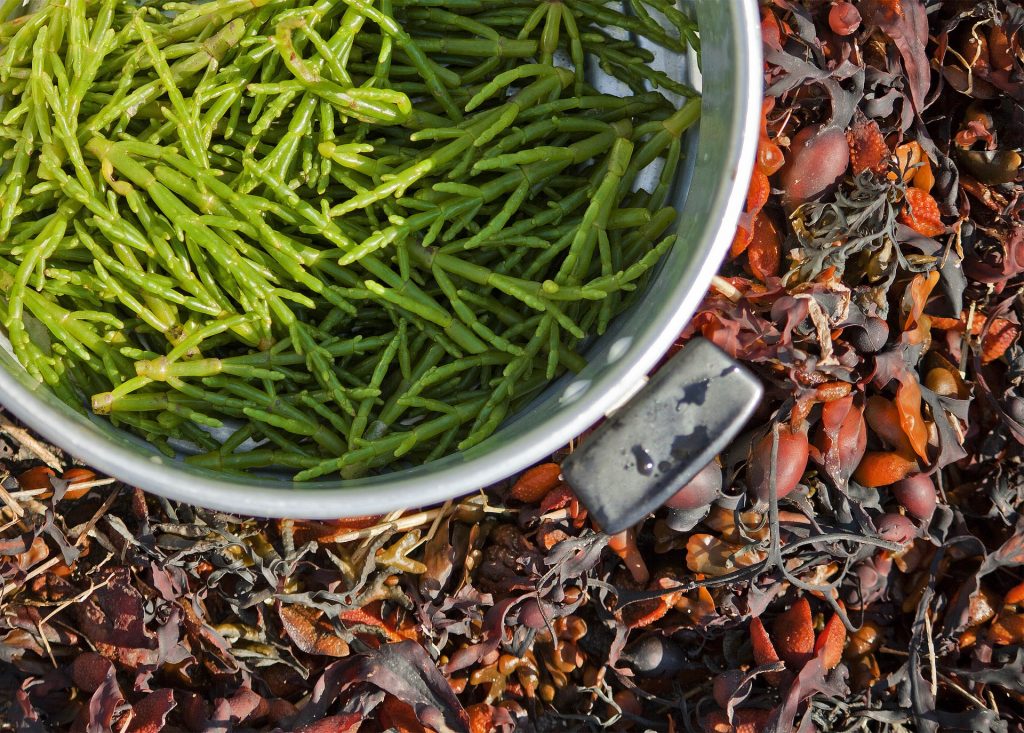During spring and summer, foraging for samphire is a pleasure. There are two types of samphire: Marsh Samphire and Rock Samphire. Although they have a common name, they are two unrelated species of plant. The salty taste of each samphire plant brings a nutritious taste of the seaside to any dish.
Rock samphire (Crithmum maritimum) is usually found on rocky coastal areas, while marsh samphire (Salicornia species) grows in salt marshes and estuaries.
Marsh Samphire (Salicornia)

Marsh Samphire, also known as glasswort, refers to a genus of plants rather than a single species. This versatile plant has a long history of being collected and used for various purposes. Not only has it been a valuable source of food for centuries, but it also served as a raw material in glassmaking until the last century.
Marsh Samphire thrives in salt marsh areas, typically found near the sea, including estuaries and mudflats. Harvesting this plant can be a bit messy due to its muddy habitat, but the rewards are well worth the effort. Late spring to summer is the ideal time to forage for Marsh Samphire.
Keep an eye out for its distinctive appearance—long, slender spikes resembling miniature asparagus stalks. They often grow abundantly, forming sizable clusters.
When harvesting Marsh Samphire, use a pinching motion or use scissors to snip off the tips of the stems. It’s important to leave the tough, yellow lower stalks intact. This practice allows the plant to regenerate, ensuring its continued growth and sustainability. It also saves time later, as you won’t need to remove the tougher parts of the plant.
How to Eat Marsh Samphire
Wash samphire thoroughly. It can be eaten raw in salads, or lightly steamed or sautéed in butter for two minutes. Do not add salt, this plant has a strong, natural saltiness. Similarly, it is best to avoid cooking in a dish with other salty foods such as bacon or anchovies.
Marsh Samphire works well with any fish dish, or try with eggs or lamb.
Rock Samphire (Crithmum maritimum)

Rock Samphire is a distinctive plant characterised by its flattened, succulent leaves and clusters of vibrant yellow flowers. It thrives during the growing season, which typically lasts from May to September. Rock Samphire is commonly found in clumps along rocky coastlines.
The plant’s unique leaves, which have a succulent texture, add to its visual appeal. They are adapted to withstand the harsh coastal environment and grow in dense clusters. The flowers, arranged in umbels, contribute to the plant’s overall beauty with their striking yellow color.
To harvest Rock Samphire, just pinch off the parts you want, and do not remove the whole plant.
Rock Samphire often grows on cliffs and can be dangerous to collect, so avoid doing so if perilous. There is still much to of it to be found at low levels, such as the foreshore of rocky beaches in the UK, so stick to safe areas.
How to Eat Rock Samphire
Like Marsh Samphire, Rock Samphire has a salty taste, yet with it comes the strong aromatic flavour of parsley. The taste is very strong and spicy, so use sparingly if raw, or try it steamed or stir fried. Traditionally, stems of Rock Samphire were preserved by pickling in vinegar.
Take care when foraging for samphire, and never pick plants from areas that are not clean. Just like you wouldn’t pick berries or greens that could have had a dog wee on them, do not pick sea vegetables from polluted areas.
Sustainable Harvesting
When foraging for samphire, remember to harvest sustainably to maintain the plant’s population and ecosystem health. Only take what you need, leaving enough plants to continue growing and support the local ecosystem. Avoid damaging the root system or nearby plant life while harvesting.
While foraging, be mindful of the wildlife and the fragile habitats you may encounter. Always respect nesting areas and breeding grounds, maintaining a safe distance from wildlife. Avoid damaging sensitive ecosystems, and make sure to leave the foraging site as you found it.
Do you forage for Samphire? Please share your recipes in the comments!
Are you interested in the idea of foraging, but are not sure how to start? Have you been wondering what you can actually cook with the wild foods you have gathered? Imagine being able to recognise wild foods, and enrich your diet for free!
What if you knew the medicinal benefits of the plants around you, and were able to make healing remedies instead of relying on synthetic medications? With that knowledge in mind, taking an outdoor stroll would take on a whole new significance and meaning.
Want to know more about foraging? Get a copy of Foraging For Health – Hedgerow Plants and Fruits now!


Like and interested in nature and foraging.
Last year there was masses of marsh samphire on the foreshore near where I live. This year at the same time there is none. The ground is much drier this year and I wondered if that could be the reason. Has anyone else experienced this?
We tend to eat our marsh samphire as a salad mixed with feta cheese, some olive oil and lemon juice. Delicious with fish or meat, especially lamb.